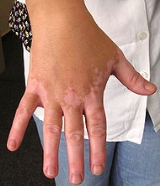
Vitiligo
Overview
Vitiligo is a condition that causes depigmentation
of sections of skin
. It occurs when melanocyte
s, the cells responsible for skin pigmentation
, die or are unable to function. The cause of vitiligo is unknown, but research suggests that it may arise from autoimmune, genetic, oxidative stress
, neural, or viral causes. The incidence worldwide is less than 1%. The most common form is non-segmental vitiligo, which tends to appear in symmetric patches, sometimes over large areas of the body.
The most notable symptom of vitiligo is depigmentation of patches of skin that occurs on the extremities.
Depigmentation
Depigmentation is the lightening of the skin, or loss of pigment. Depigmentation of the skin can be caused by a number of local and systemic conditions. The pigment loss can be partial or complete...
of sections of skin
Skin
-Dermis:The dermis is the layer of skin beneath the epidermis that consists of connective tissue and cushions the body from stress and strain. The dermis is tightly connected to the epidermis by a basement membrane. It also harbors many Mechanoreceptors that provide the sense of touch and heat...
. It occurs when melanocyte
Melanocyte
-External links: - "Eye: fovea, RPE" - "Integument: pigmented skin"...
s, the cells responsible for skin pigmentation
Human skin color
Human skin color is primarily due to the presence of melanin in the skin. Skin color ranges from almost black to white with a pinkish tinge due to blood vessels underneath. Variation in natural skin color is mainly due to genetics, although the evolutionary causes are not completely certain...
, die or are unable to function. The cause of vitiligo is unknown, but research suggests that it may arise from autoimmune, genetic, oxidative stress
Oxidative stress
Oxidative stress represents an imbalance between the production and manifestation of reactive oxygen species and a biological system's ability to readily detoxify the reactive intermediates or to repair the resulting damage...
, neural, or viral causes. The incidence worldwide is less than 1%. The most common form is non-segmental vitiligo, which tends to appear in symmetric patches, sometimes over large areas of the body.
The most notable symptom of vitiligo is depigmentation of patches of skin that occurs on the extremities.

